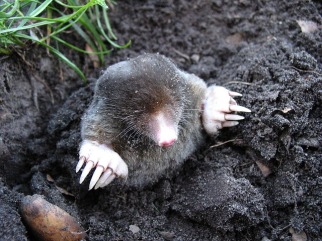Before you read this post, I suggest you read posts 16.27 , 16.30 and 16.33.

No, this post isn’t about the mole in the picture. It’s about a completely different type of mole – the mass of a pure substance that contains the Avogadro’s number (post 16.27) of molecules (post 16.30).
As an example, we’ll think about a molecule of glucose – it contains 6 carbon atoms (post 16.30), 12 hydrogen atoms and 6 oxygen atoms; so we represent glucose by the formula C6H12O6. The relative atomic masses of carbon, hydrogen and oxygen are 12, 1 and 16, respectively; so, the relative molecular mass (post 16.33) of glucose is
(6 × 12) + (12 × 1) + (6 × 16) = 180.
Now we define 1 mole (abbreviated to 1 mol) of glucose to be 180 g of glucose.
Why do we define the mole in terms of grammes and not kilogrammes, which are the SI unit of mass (post 16.13)? The reason is that the mole was defined before SI units were widely used (see post 17.14); unfortunately, the definition of the mole (like the definition of Avogadro’s number, post 16.27) has never been updated.
How many molecules are there in our mole of glucose? The answer is the mass of a mole of glucose (in grammes) divided by the mass of a molecule of glucose (in grammes). The mass of a mole of glucose is 180 g (see above); the mass of a molecule of glucose is 180/N g, where N is Avogadro’s number (post 16.27). So the number of molecules in 1 mol of glucose is
180/(180/N) = 180N/180 = N.
We could do the arithmetic for any other molecule and find that a mole of anything contains Avogadro’s number of molecules.
As a result, there are two equivalent definitions of a mole:
One: calculate the relative molecular mass of any substance and a mole of that substance is that number of grammes of the substance
Two: a mole is the mass of a substance that contains its Avogadro’s number of molecules.
Some substances, like the gas neon (post 16.29) exist as individual atoms. The relative atomic mass of neon is 20, so a mole of neon is 20 g.
Other substances exist not as molecules but as equal numbers of positively and negatively charged ions (post 16.39). For example, sodium chloride (the “salt” we add to our food) is a mixture of equal numbers of sodium (Na+) and chloride (Cl–) ions. The relative atomic masses of sodium and chlorine are 23 and 35.5 respectively. So, we define a mole of sodium chloride to be 23 + 35.5 = 58.5 g, even though sodium chloride doesn’t contain any molecules.
If we have a solution of 1 mol of a substance in 1 litre (1 L) of solution, we say that we have a molar solution of the substance. 1 L is equal to 1 dm3, where 1 dm = 0.1 m. Once again, SI units are completely ignored in these definitions! When we measure the concentration of a solution relative to the concentration of a molar solution we call the result the molarity of the solution; the abbreviation M is conventionally used to define molarity. So, a 0.1 M solution of glucose has 1/10 the molarity of a molar solution and so has a concentration of 180/10 = 18 g of glucose in 1 dm3 of solution. Sometimes M is written as a small capital letter. Why? Because there is a SI definition of molar that is different to the one I’ve given but is not often used! All this is very tedious and confusing – it’s explained at https://en.wikipedia.org/wiki/Molar_concentration. It would be better if we had proper SI definitions of all units and always used them – but, unfortunately, this isn’t what happens for moles and molar solutions!
Notice that the molarity of a solution is its concentration relative to that of a molar solution. So molarity isn’t measured as a mass divided by a volume (the units of concentration) – it’s just a number because, for example, a 2 M solution is twice as concentrated as a molar solution. This isn’t usually made clear in books but is important when we use the idea of molarity to define the pH scale which measures the acidity or alkalinity of a solution. This paragraph may be clearer if you’ve read post 17.41.
We will use the idea of molarity to define the strength of acids in the next post.
Related posts
16.40 Complicated ions
16.39 Ions
16.33 Chemical reactions
16.30 Molecules
16.27 Atoms
I love people who are passionate about what they do. I have read with great pleasure each and every post that David has made in this series. Each time, I am struck by the great prevelidge that we all have; here is someone with a huge insight into both physics and biology who takes the time to explain things a fun way that makes us all appreciate the basics of sciene a little bit better. David, thank you so much for sharing your passion and your gift.
LikeLike